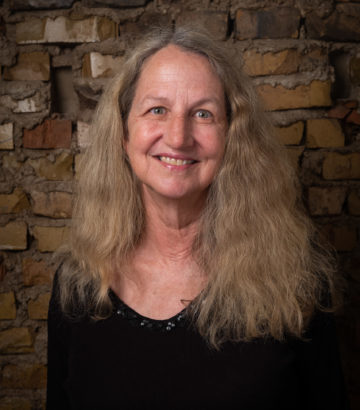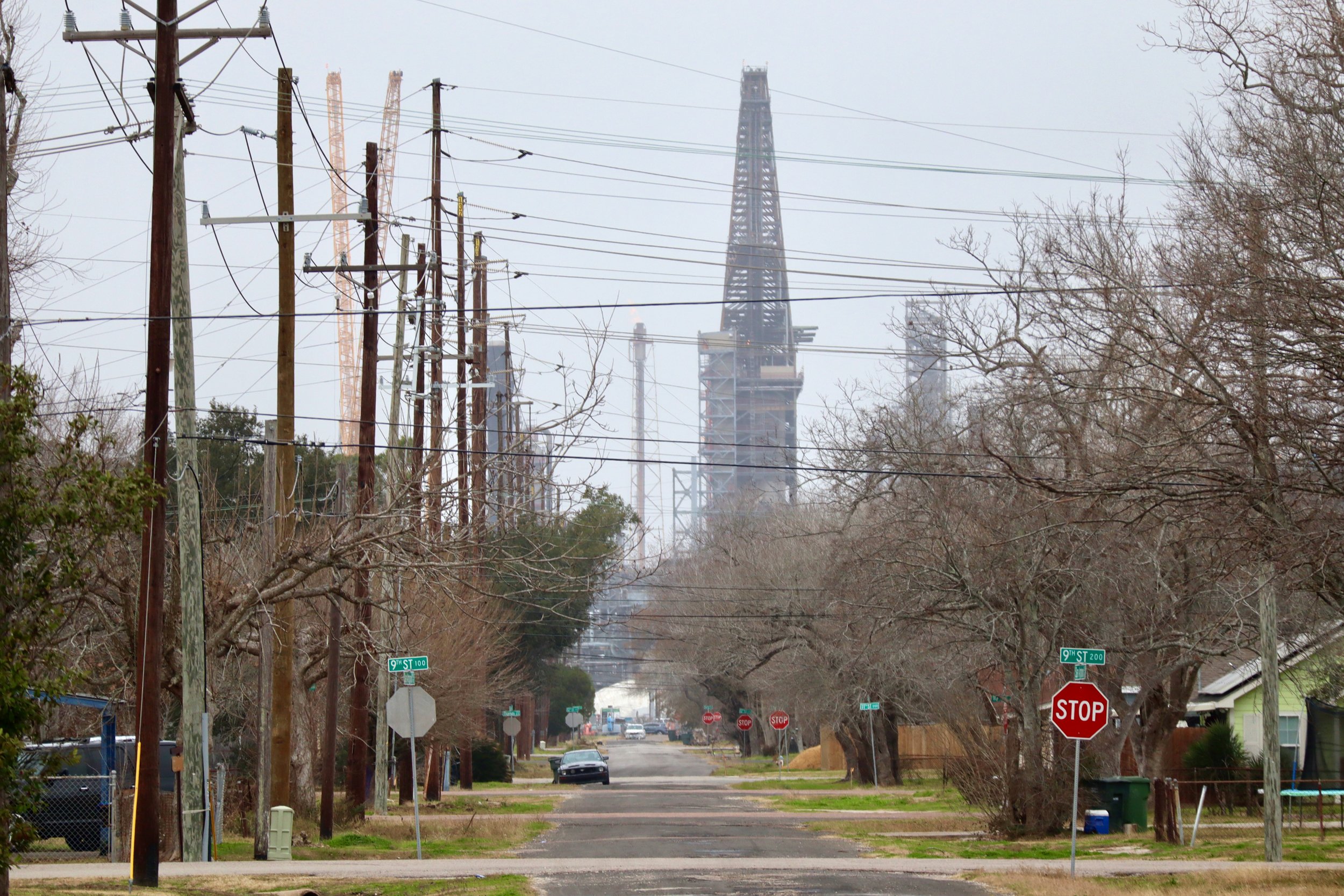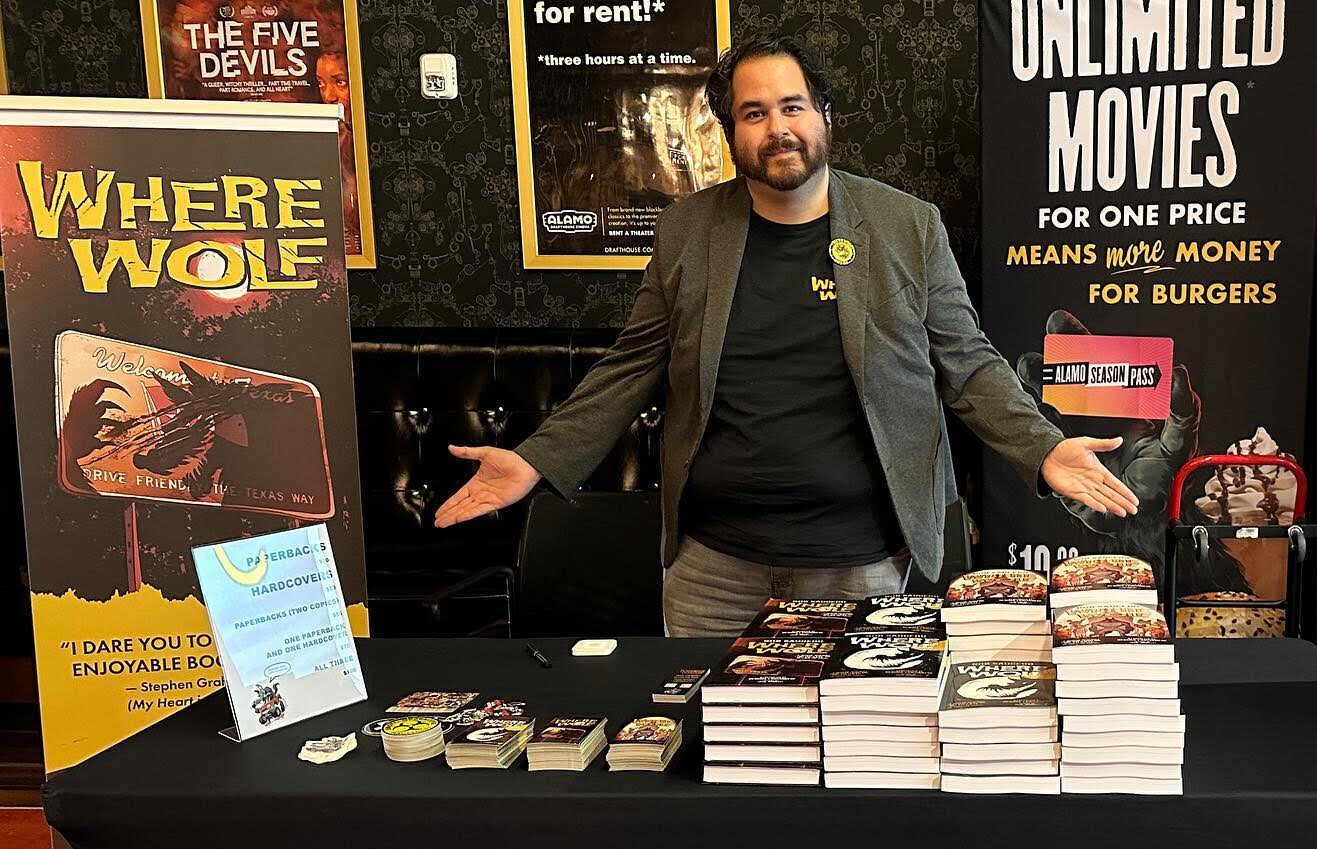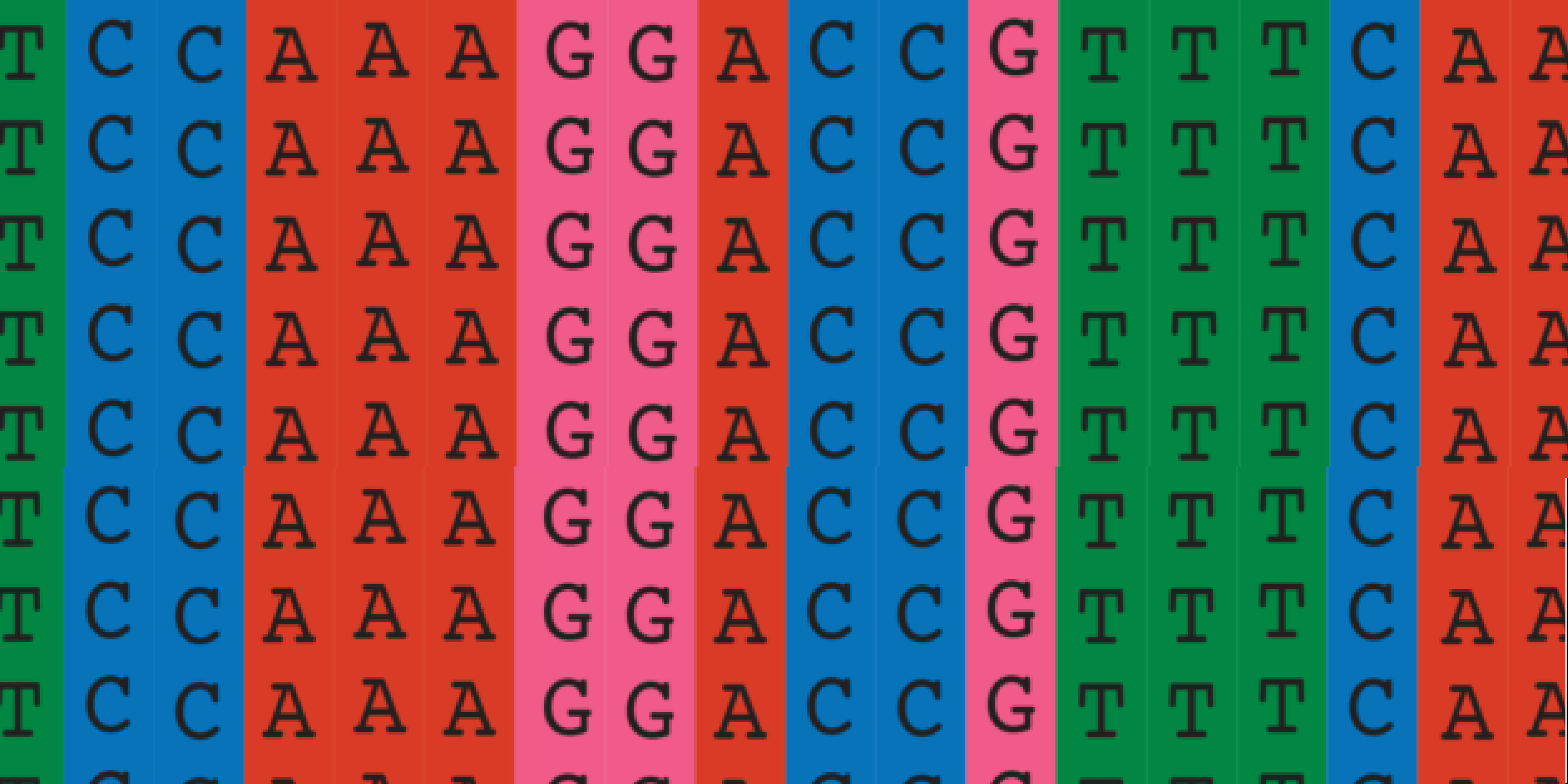
For nearly 30 years, Dianne Gonsoulin Hastings tried to discover what befell her big sister.
Donna was petite, rail-thin, and had a distinctive dark-eyed charm. As a girl and young woman, she loved to go crabbing on Pleasure Island, standing for hours on a rocky jetty that poked out into the Gulf of Mexico until night fell and dawn broke. She loved Janis Joplin, another free-spirited Port Arthur native. And she loved to sing outside, belting out Joplin lyrics like “Freedom’s just another word for nothing left to lose.”
Then she disappeared, leaving no word with her siblings, her large band of close-knit Cajun cousins, or her kids—the two boys she loved.
Donna, Dianne, and their four siblings grew up in a brick house near Port Arthur’s sea wall. Their parents’ marriage fell apart when the girls were small, and their father, a decorated combat veteran, struggled with both post-traumatic stress disorder and alcoholism.
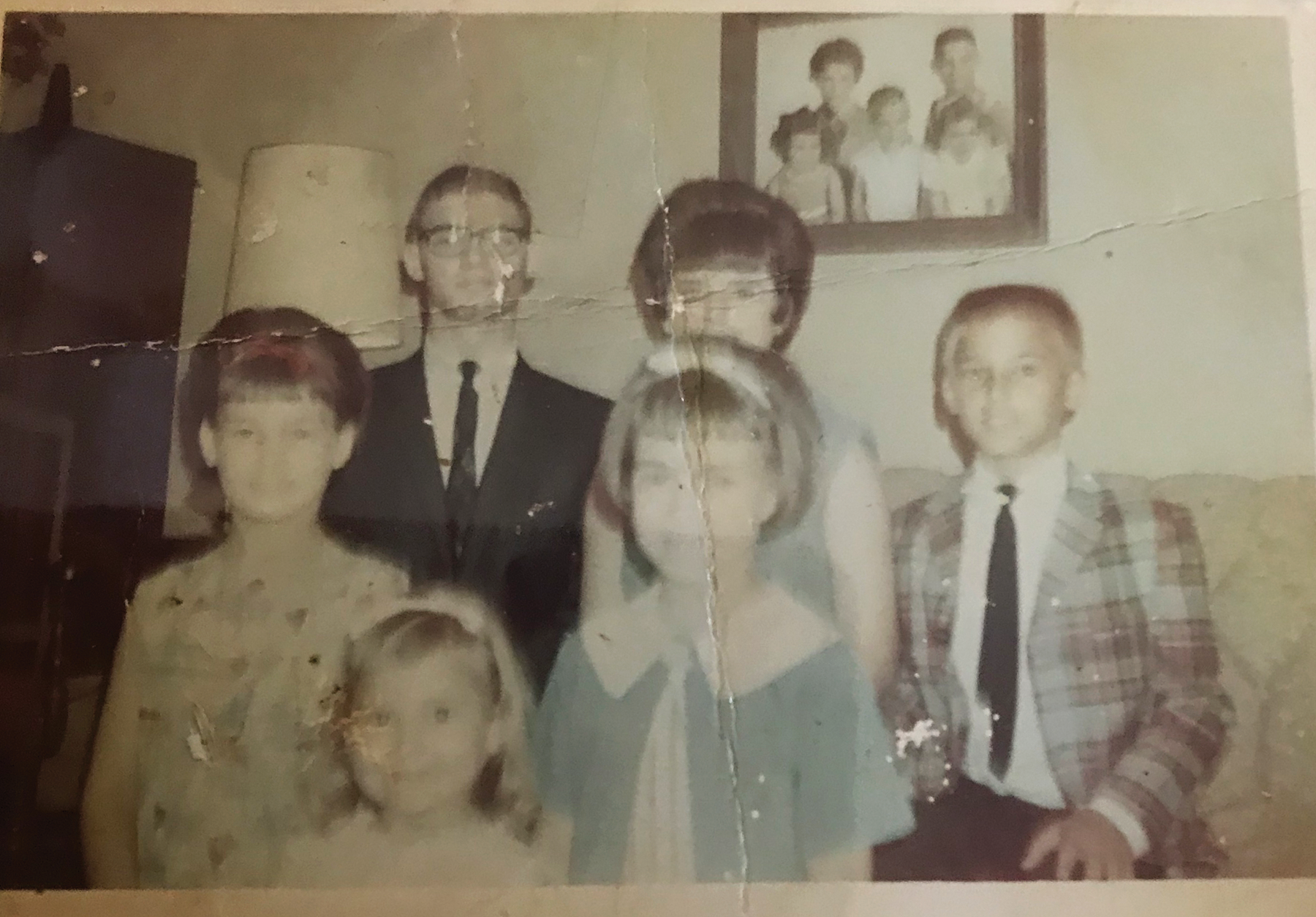
In her teens, Donna left home to marry her childhood sweetheart and soon had her own family. They were happy, until Donna’s husband began to drink heavily too. Dianne got several calls to “rescue” her sister and nephews after he turned violent while drunk. In the last episode, Donna was hospitalized with a broken eye socket and dozens of stitches. “I will never forget what I saw when I walked in the room,” Dianne says.
Quietly, Donna and her boys sought shelter and slipped away. For two years, they lived happily in Austin. But Donna also struggled with substance abuse. In 1989, she brought the boys to live—temporarily, she thought—with their paternal grandmother in Louisiana. She moved to Houston and promised to send for them when she “could rebuild her life.”
In her last call to Dianne, in October 1989, Donna mentioned a trip to Mexico. So when she didn’t get in touch again, Dianne worried but assumed her sister was traveling. Panic set in after months passed, and then years.
Donna’s last mailing address was on Bay Area Boulevard in Clear Lake, a southern suburb of Houston that bumps up against League City and other small coastal cities along Galveston Bay. She lived only a few miles from an abandoned oil field, a 25-acre spot with spiky stands of trees in League City called the “Killing Fields” because it had been used as a dumping ground by an unidentified serial killer.
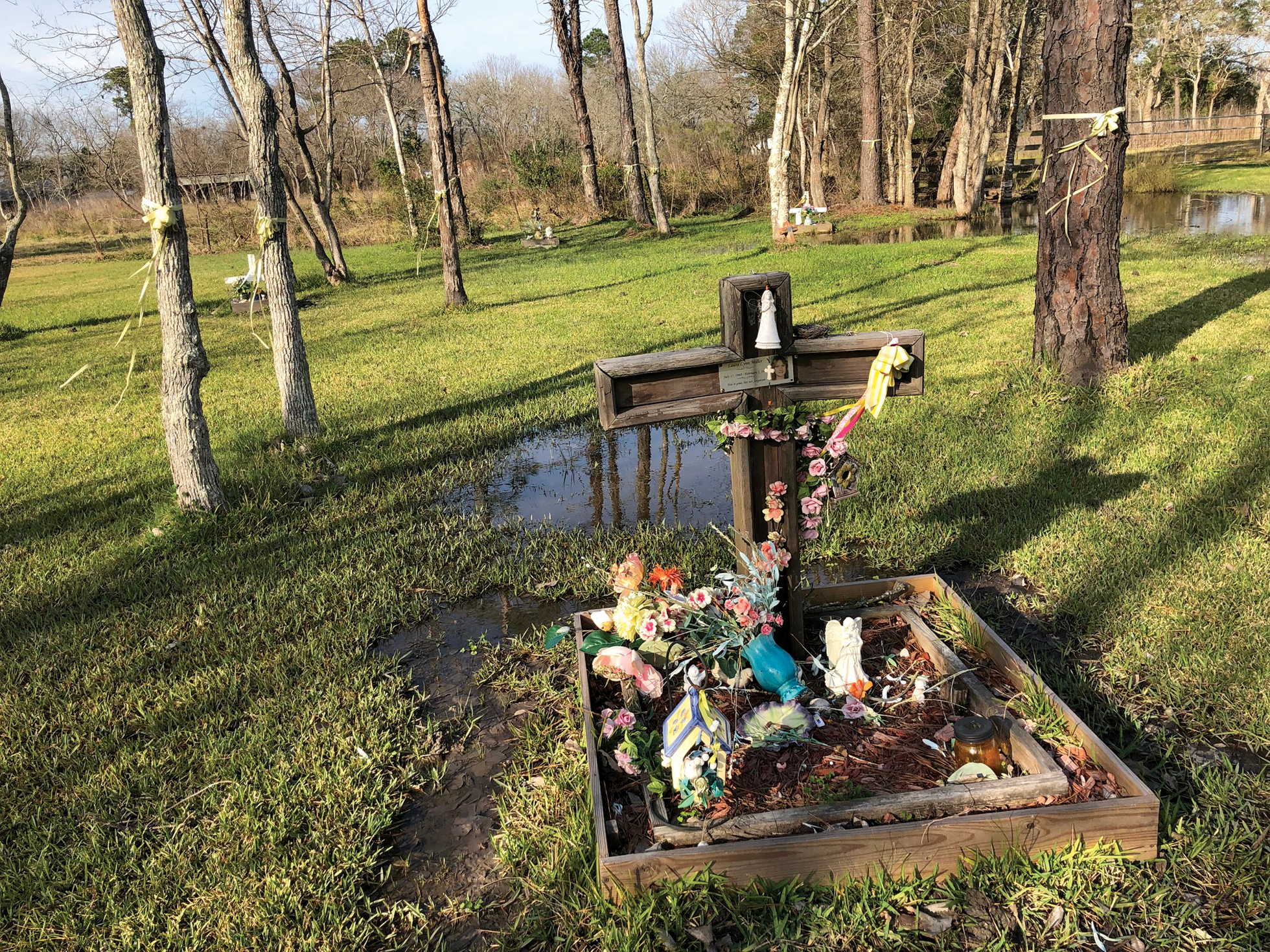
Dianne heard news stories about that field, where discarded remains of three women were recovered—all strangled, left nude and seemingly posed. First, Heidi Villareal Fye, a local bartender, disappeared in 1983 and was found there in 1984. Then Laura Miller, only 16, went missing after walking to a pay phone to call her boyfriend. She was found in 1986, near the remains of a third woman, dubbed Jane Doe.
In the summer of 1991, a man riding his horse on trails through the property found the fourth victim. Her body had badly decomposed in the sweltering heat. A forensic artist’s sketch based on a skull, sun-bleached hair, and guesswork didn’t help identify her.
Police gave her a new name: Janet Doe.
The remains of Janet and Jane Doe were stored for decades in a box inside a mobile storage building in Texas City. They sat on a shelf alongside dozens of other unidentified bones and cold case samples collected by the Galveston County Medical Examiner’s Office.
An estimated 40,000 unidentified bodies and samples are stored in coroners’ offices, medical examiners’ labs, and paupers’ graves all across America. Until recently, many long-lost identity cases seemed hopeless. Only 15 Texas counties are large enough to support a medical examiner’s office with at least one licensed forensic pathologist or any staff trained to investigate unidentified deaths.
Nationwide, a publicly available search tool called NamUs provides lists of the unidentified and of missing persons, cases submitted by police and medical examiners. In Texas, 1,630 John and Jane Doe cases were registered as of April 2020. Dianne called Port Arthur police in 1992 to report Donna’s disappearance and later contacted a private investigator. But Donna’s name was never added to the NamUs registry.
Around half of Texas’ unidentified persons have remained nameless for more than 20 years. Often, investigators can only guess their age or race. In more than 100 cases, officials lack enough bones or body parts to even determine gender.
Then, in 2017, an unexpected breakthrough began to bring rapid resolution to more than two dozen of America’s oldest lost identity cases. A homespun network of cold case detectives, amateur genealogists, and geneticists has cracked cases in Texas, Idaho, Washington, and other states using an identity-solving tool unintentionally built through Americans’ collective curiosity about our roots.
An estimated 40,000 unidentified bodies and samples are stored in coroners’ offices, medical examiners’ labs, and paupers’ graves all across America.
Through home kits—based on saliva collected in a plastic vial—an estimated 30 million people have voluntarily submitted DNA samples to various consumer DNA companies.
Two companies also allow people to contribute their data for broader searches: GEDmatch, which offers free uploads, and Houston-based Family Tree DNA, which charges for its services. Queries of those databases can find very distant cousins, aunts and uncles, and other long-lost relatives, calculated by comparing shared genetic markers. Police soon realized that through those same two sites, DNA profiles developed from so-called John and Jane Does—or from suspect samples at crime scenes—could be matched to potential relatives too.
That new process, called genetic genealogy, doesn’t result in magic solutions. Even after relatives are identified, the process of confirming a lost identity (let alone catching a killer) is complex. Most searches unearth only distant kin, who provide clues to a larger puzzle: Who is a common ancestor that links them? Can that ancestor then be tied to any missing descendant?
But it has had jaw-dropping success: Five of Texas’ oldest lost identity cases have been resolved since 2018. At least eight more are being actively worked. And dozens of suspects in Texas murders and other crimes have been traced through the same process, though no government agency or group tracks cases solved through genetic genealogy.
Most consumer DNA companies do not allow law enforcement searches without a warrant. Those that do have policies to restrict the use of forensic queries. Family Tree DNA, for example, limits searches to tracing families of the unidentified, killers, rapists, or child abductors.
But some ethicists, attorneys, and state lawmakers fear that law enforcement’s use of consumer DNA datasets could have unintended consequences. Critics say privacy will be invaded, the wrong people will be targeted, the rights of the accused will be violated, and the police will soon tap consumer DNA profiles for myriad purposes.
“It’s worth asking whether this investigative technique should be available at all.”
Vera Eidelman, an attorney at the American Civil Liberties Union (ACLU), acknowledges that the technology allows individuals to make powerful discoveries. “I think where it becomes troubling is when law enforcement has access to that information—particularly when people did not intend in any way for their information to be used for law enforcement purposes,” she says.
Eidelman says investigators already have pushed the limits. In the past two years, they’ve talked labs into testing evidence from cases that fall outside company policies and targeted the wrong relatives as suspects. She also worries about how police have confirmed some matches by collecting and testing items, like coffee cups or tissues, discarded by potential suspects instead of obtaining proper warrants. “It’s worth asking whether this investigative technique should be available at all. And if it is available, it’s important to have guardrails and it’s very important to note all of the privacy implications,” she says.
There’s already been enough of a backlash that some advocates of the technique fear that the seemingly miraculous progress in solving crimes and lost identity cases could slow—or even stop. But families of missing persons, people like Dianne Gonsoulin Hastings, insist searches for America’s lost must continue.
It was 27 years after Janet Doe’s death when Richard Rennison, an FBI agent who’d been a League City police detective in the 1980s, contacted his former department to explain how searches of DNA collected by consumer companies could crack cold identity cases. Rennison was focused on two Texas Killing Fields victims: Jane and Janet Doe.
The innovation had been making national headlines after a combination of DNA tests and genealogy research led California investigators to identify the so-called Golden State Killer, a man who had allegedly committed 13 murders and even more rapes since the mid-1970s. In April 2018, officers arrested a 72-year-old named Joseph James DeAngelo Jr.
For years, the FBI had been collecting DNA from crime scenes and convicted criminals and storing profiles in a confidential law enforcement tool called the Combined DNA Index System, or CODIS. At least 10 states, including California and Texas, already allowed familial searches of forensic DNA databases. But these never led to DeAngelo, an ex-police officer whose DNA had never been entered as a criminal.
Instead, investigators later traced his kin by using a different type of DNA test that could be compared with consumer data stored by both GEDmatch and Family Tree DNA. Most consumer DNA companies use a process called autosomal SNP testing (which stands for single nucleotide polymorphisms, used to compare genetic variations among people), pronounced “snip.” Through those tests, labs examine 700,000 points, or “snips,” for each individual. Profiles generated from those tests—which can cost from $100 to $700 per sample—enable people to learn more about their origins and identify far more distant relatives.
The at-home kits have proved popular. By 2017, consumer DNA testing was a $359 million market, projected to double by 2023. Nationwide, there’s enough data in all consumer DNA databases to find family for most Anglo-Americans, experts say, though the searches are far less powerful for recent immigrants and members of other minority groups. So far, only a fraction is available for forensic searches.
Conducting all the testing necessary to generate matches and to later confirm identities can cost anywhere from $3,000 to $10,000.
Victims’ advocates saw an opportunity: Perhaps thousands of the nation’s 40,000 unidentified person cases could be resolved. Quietly, police in League City and many other places began to solicit new tests of old forensic evidence and upload profiles.
Yet when the thrill of catching the California serial killer faded, public debate surged about whether police should be allowed to access consumer DNA databases at all. Only about half of Americans favored using consumer DNA data for criminal investigations, according to a Pew Research Center survey. But the poll didn’t ask about Jane and John Does, thousands of people unable to speak for themselves. The ACLU, which opposes the use of consumer DNA databases for criminal investigations, has no official opinion on lost identity cases, attorneys said. In 2019, the U.S. Department of Justice issued a draft policy calling for the technique to be reserved for murder, rape, and identification cases—and used as a last resort.
In response to pushback, operators of GEDmatch, the nation’s largest free consumer DNA repository, took all of its data offline for forensic queries and required consumers to opt in before any information could be provided. Only about 250,000 of about 1 million records have since become available. (GEDmatch, acquired by California-based Verogen in December, did not respond to a request for comment on its plans.)
Meanwhile, in December 2018, the only other major DNA repository used for forensic searches, Family Tree DNA, quietly approved a policy allowing police to access a database with more than 1 million profiles for researching killers, rapists, child abductors, and the unidentified. Four months later, in March 2019, the company asked U.S. customers via email to proactively say if they wanted to opt out. Only about 3 percent did.
In the company’s eighth-floor lab in an office building off Houston’s 610 Loop, workers unload huge black plastic bags filled with test kits, sent in mostly by U.S. customers looking to build family trees and find far-flung relatives. The workers carefully unwrap packages containing the kits, label sample tubes, and line them up to be processed in the intricate computerized assembly line.
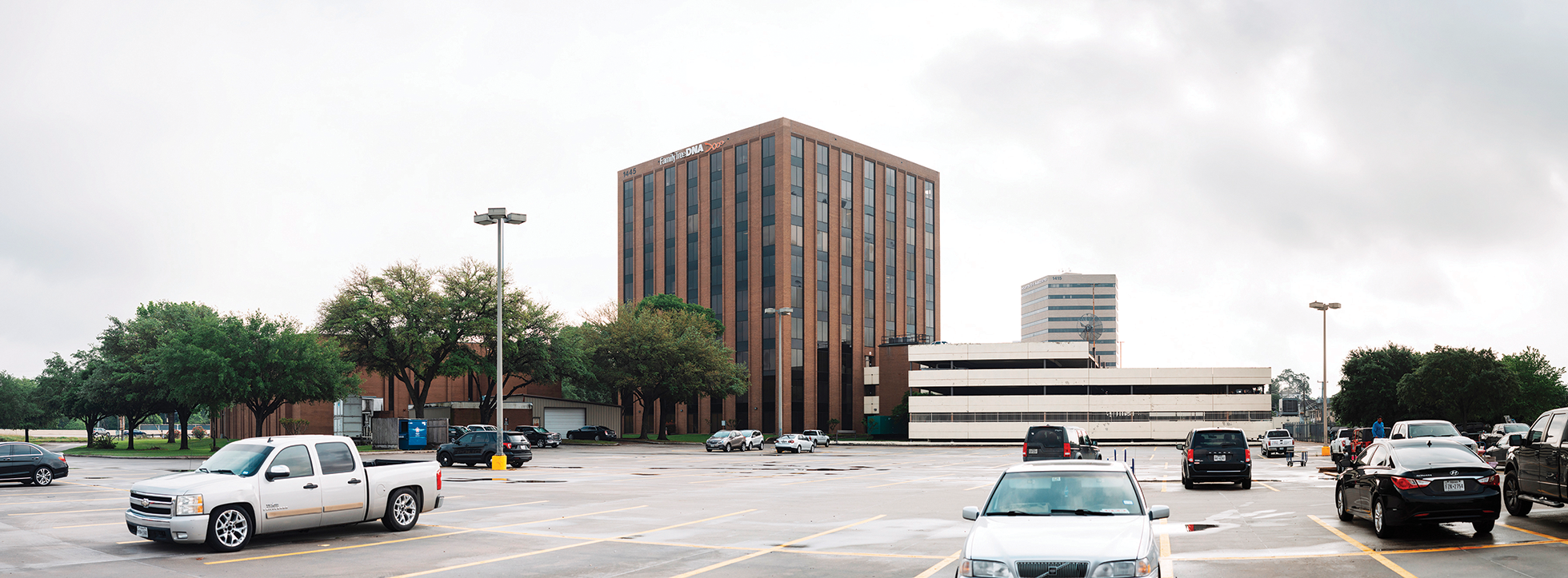
Connie Bormans directs this lab and has seen it rapidly grow in the past decade. In her days as a postdoctoral research fellow at the University of Texas Health Science Center at Houston, Bormans explored genetic links to heart disease. She never intended to use her knowledge to fight crime, though it’s now a growing part of the company’s business.
Just above her office, inside the company’s secure lab, a humming assembly line of stainless steel machines driven by computers systematically washes, tests, and catalogs samples. DNA is extracted from cells, then DNA autosomal SNP tests are conducted, and later, data profiles are produced, Bormans explains. Each bar-coded DNA sample is placed into secure cold storage. The statistical profile, built for each sample, is run through a computer that pulls different kinds of matching genetic information from the company’s database. Analysts then use that data to generate lists of types of relatives and to describe ethnic origins. Parents share about half their DNA markers with children. As relationships grow more distant, the percentage of shared DNA declines. Labs estimate relationships based on those figures.
Bormans says that the lab’s work in identifying victims and criminals arose from earlier efforts to locate unknown relatives of adult children from closed adoptions. The company had already processed samples from adoptees denied information about parenthood, people whose families were basically “unidentified,” Bormans explains. From there, it seemed natural to help identify John and Jane Does. Bormans told the Observer that the company has so far helped solve at least 27 cases. Family Tree DNA, a privately held company, doesn’t disclose its profits or how much money it makes from law enforcement-related work. Bormans said the lab has processed hundreds of forensic samples in the past two years, though they remain less than 1 percent of the total number processed.
For Family Tree DNA, this is business.
Nationwide, no governmental agency is spearheading the effort to resolve lost identity cases—or research unsolved murders or rapes—through genetic genealogy. Accordingly, there are no regulations or standard guidelines. There’s also no central funding. And conducting all the testing necessary to generate matches and to later confirm identities can cost anywhere from $3,000 to $10,000, for a more complex case, Texas investigators say.
Colleen Fitzpatrick, a California-based physicist with Texas ties (she earned one of her degrees at Rice University and taught at Sam Houston State University), is widely recognized as the founder of modern forensic genealogy. In 2017, she and Margaret Press, also a forensic genealogist, co-founded a nonprofit to raise money and help identify the nation’s unidentified, the nameless who perished in murders, suicides, and natural deaths. They call it the DNA Doe Project.
“The time had come, the technology was there, and the databases had gotten big enough—this was just the next step,” Fitzpatrick says.
Many police departments, medical examiners, and coroners who oversee Doe cases lack resources. They have increasingly begun to call on outside experts, including members of the DNA Doe Project, for assistance. As of April, its volunteers—an eclectic mix of genealogists, retired police officers, private investigators, and other skilled researchers—were working about 70 active cases nationwide and already had helped solve about 30 others.
In December, the group announced it’d helped identify a headless torso found in a burlap sack in a cave in Idaho in 1979. The victim was Joseph Henry Loveless, a bootlegger and bank robber who escaped jail in 1916 only to disappear. That case was cracked based on a family tree with more than 30,000 names—all connected to people who’d matched to DNA extracted from his century-old bones.
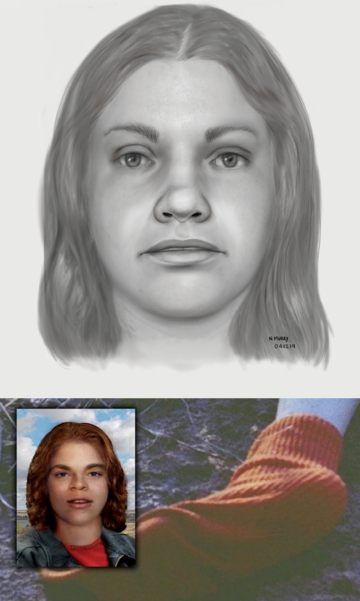
So far, its oldest case in Texas was a Williamson County murder victim known for four decades as “Orange Socks.”
The temperature had dropped to 40 degrees and a light rain fell on Halloween in 1979 when a passerby spotted the nude body of a young woman lying inside a concrete drainage ditch north of where Walburg Road crosses Interstate 35. The woman had likely been strangled elsewhere before someone pulled off the highway’s busy southbound lanes to dump her body near the Austin suburb of Georgetown. She was wearing only pumpkin-colored socks.
Sergeant John Pokorny reopened the case in 2017 when the Williamson County Sheriff’s Office formed its cold case unit. To use genetic genealogy, investigators first had to find enough evidence for DNA-SNP tests. They finally discovered it at the University of North Texas’ Identity Lab, remembers Pokorny. The department paid one private lab to conduct the DNA-SNP test and another to convert the data into the profile needed for searching consumer databases. They sent off a possible suspect sample for testing too.
To help identify potential relatives, Pokorny turned to Kevin Lord, a private investigator and leader of the DNA Doe Project in Texas. By then, Lord and his team of amateur sleuths already had helped identify the victim of a 13-year-old murder case in Longview.
Answers in the Orange Socks case came in August 2019 through a stroke of luck. As part of the investigation, Williamson County investigators released an updated portrait to the press. An Abilene woman who’d recently moved to Georgetown called to say she recognized the woman in the sketch as her sister, Debra Jackson. Another DNA test confirmed a sibling match.
Lord later set up a team to help Pokorny identify another young woman found dead of gunshot wounds alongside Interstate 35 in 1989. She died wearing a beer T-shirt and for years had been known only as “Corona Girl.”
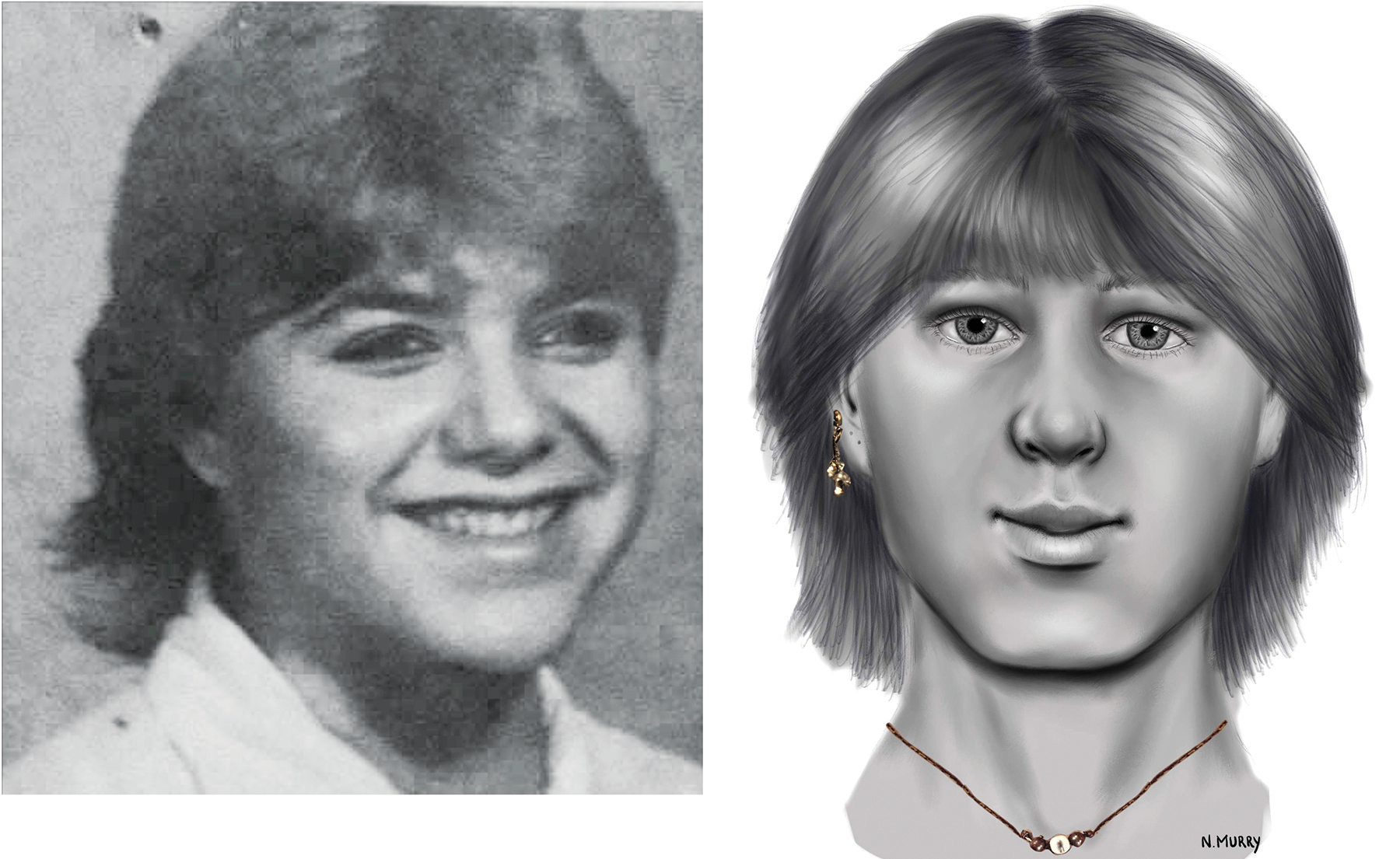
Usually soft-spoken, Lord became animated as he spoke of how researchers combed through newspaper archives, obituaries, cemetery data, and maps to create a 1,700-person family tree for Corona Girl. Once common ancestors are identified (in her case, a set of great-grandparents), they track descendants to try to discover who disappeared.
Corona Girl had roots in rural Arkansas, so Lord focused his search there. In January, Williamson County officials announced they had solved the mystery. Corona Girl was Sue Ann Huskey, the youngest of seven siblings, a 17-year-old last seen in Sulphur Springs, Texas, nearly 250 miles away.
Pokorny hopes that finally unlocking the identities of Jackson and Huskey will bring new clues in their cold murder cases. The suspects include known serial killers who roamed Texas highways in the 1970s and 1980s.
In 2018, Galveston County-based investigators began their own search by requesting stored samples from Jane and Janet Doe found in the Texas Killing Fields. League City police paid a Florida lab to conduct DNA-SNP tests and another lab to generate profiles to compare with consumer databases. They submitted the profiles both to GEDmatch and Family Tree DNA. GEDmatch quickly produced three names in Louisiana.
In the first four months of 2019, Detective Recie Tisdale spent months making phone calls to Janet Doe’s distant relatives. None knew of any missing family members. Then Tisdale got more leads from a Louisiana bookkeeper-turned-genealogist named Shera LaPoint.
LaPoint runs a small business helping adoptees and others find relatives. She knew Cajun family trees could be tricky. Many extended families remained in the same parishes for decades. Over time, branches crisscrossed and tangled from generations of marriages. LaPoint herself was very distantly related to Janet Doe through her father-in-law. The family tree she built for Janet Doe included 2,677 people. “I had been probably working for eight hours a day trying to figure this out,” she says. “That’s how intense this is when we do these things.”
Finally, LaPoint connected all three matches—tracing her father-in-law to the dead woman through a colorful great-great-grandmother who “made moonshine that she hid inside of her chicken coop,” she says. She called Tisdale and suggested he focus on relations who’d moved from Louisiana to East Texas. She thought he’d find answers among people who shared an unusual Cajun surname: Gonsoulin.
Then Tisdale received another clue from Family Tree DNA. It turned up a much closer relative: a first cousin or an uncle.
Raymond Guidry was a reluctant Family Tree DNA customer. A retired pharmacist, Guidry spends most of his days dispensing advice to visitors from a recliner in his living room in Nederland, in the Golden Triangle of East Texas.
His wife, Gloria, a retired nurse, has decorated their home with carefully arranged crosses, family photos, and a large framed print of the Last Supper. Sending a DNA sample off to the Houston lab was her idea. She was interested in her husband’s roots, relatives, and health history but found the first report disappointing. It confirmed his ancestry as Western European.
“The time had come, the technology was there, and the databases had gotten big enough—this was just the next step.”
“We knew they were all French,” she recalled, sitting in the cozy living room near her husband and shaking her head. Like so many others with Louisiana roots, the Guidrys descended from French immigrants forced out of Canada after the British conquered the region known as Acadia. She already knew her husband’s parents came from the town of Broussard, founded in 1884 by Acadians. One Cajun cousin still lives in a large white house that their great-grandfather built near the Catholic church around which town life revolves.
But the second email from Family Tree DNA made her think God had a hand in this business. It revealed that her husband’s closest relatives included an unknown woman, deceased in 1991. A cousin or a niece.
Their beloved niece Donna Gonsoulin Prudhomme had been missing for nearly 30 years. “It was a miracle,” she said.
A phone call arrived shortly after that email. Detective Tisdale first reached Gina Guidry Hale, a nursing professor and Raymond and Gloria’s daughter. When he identified himself as a cold case detective, Gina felt a surge of excitement. “I’m pretty sure I know who you’re looking for,” she said. “My cousin Donna.”
By the next morning, the detective was en route to Austin to meet Donna’s only surviving sister.
Dianne Gonsoulin Hastings had never stopped searching for Donna. She shares her sister’s sly grin, that soft Cajun drawl, and dark-eyed charm. She’s quick to laugh—and to cry.
Her tiny but immaculate Austin apartment contains many family heirlooms: her dead mother’s photo albums, a large framed portrait of Donna, her father’s red leather-bound Bible.
When detectives first called in April 2019, Dianne, 56, had just celebrated a hard-fought two years of sobriety. Her mother, father, and siblings were all gone, and she felt alone. She’d recently written her story for a recovery newsletter, describing how one sister had been murdered by her husband, four others died young, and Donna—well, Donna had simply disappeared.
Dianne had her own children and had enjoyed a successful career in health care. But with so much tragedy in her life, she sometimes wondered why God had spared her. When the call came, she thought: “Maybe I’m still here for this.”
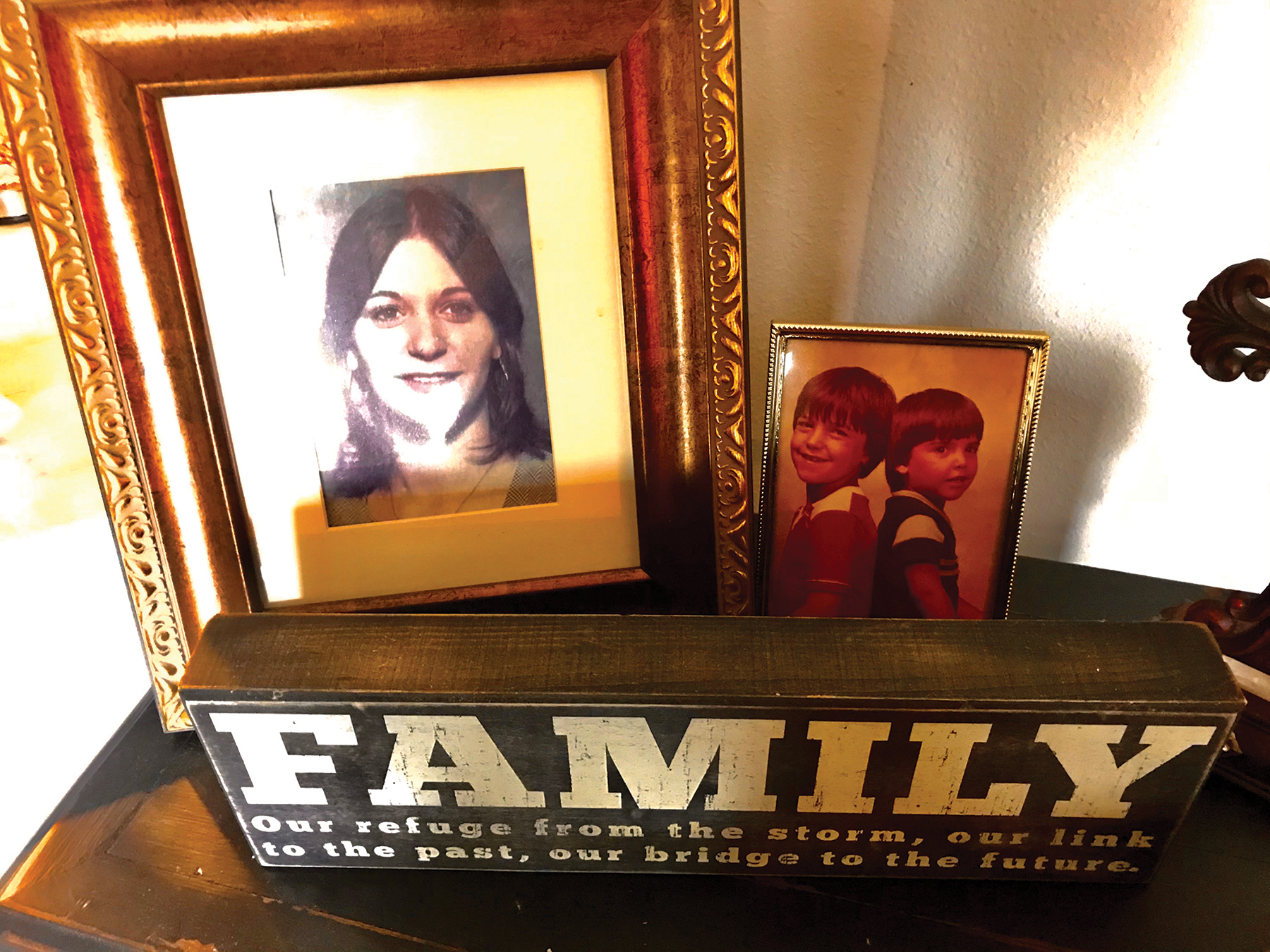
Donna’s sons had been just 12 and 16 when their mother vanished. Even as they grew into men, they never stopped asking: “Aunt Dianne, have you found my mama yet?” The news came too late for Chad Prudhomme, Donna’s oldest, who died in 2008 at age 34. He’d been badly injured in a car accident and spent his last years in nursing homes. But Dianne called the youngest, Brad, right away.
In that call, they didn’t discuss how Donna’s identity had been restored. They both sobbed. “It was so hard,” she says. She had finally found his mama.
She still can’t speak of that call without crying. The discovery brought both renewed grief and relief. Donna never abandoned her boys. Donna never willingly left behind her far-flung and close-knit family. Looking back, Dianne marvels at how often she drove by billboards with artists’ images of the Killing Fields victims but never recognized that face. Forensic artists must make guesses when drawing portraits from bones or bodies. The eyes of the woman on those billboards were not as round or as dark as Donna’s. The face was too full and the hair color too light.
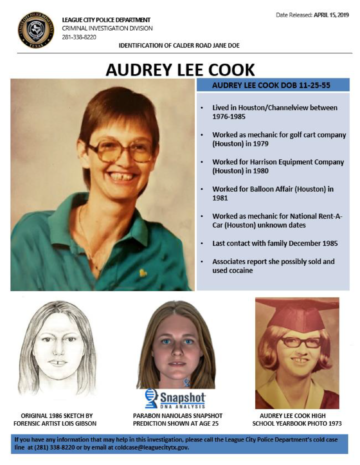
After they identified her, Tisdale and other investigators discovered that Donna spent about two years in the Clear Lake area before she disappeared at age 34 in 1991. She briefly worked in an upholstery shop and used at least three local addresses. They think she frequented local bars and last lived in the small city of Nassau Bay.
Tim Miller, the father of murder victim Laura Miller, told Dianne that he, too, failed to recognize Donna, though she once dated a construction worker he knew. Over the years, Miller had become so obsessed with the unsolved cases that he founded the nonprofit Texas EquuSearch, which helps find missing persons. He also erected crosses and built monuments to all four women in the field off Calder Drive where their bodies were found. Wind chimes swing in the branches of trees above what looks like miniature graves marked with keepsakes, plastic plants, and photos. For nearly 40 years, one marker read only “Janet Doe.” Now it says “Donna Gonsoulin Prudhomme.”
Through genetic genealogy, Jane Doe has also been identified: Audrey Lee Cook, a Tennessee native who had worked in Houston as a mechanic. She was murdered at 30. The killer remains unidentified, though investigators have named one potential suspect.
Dianne is not focused on the unsolved mystery. Instead, she concentrates on healing. Genetic genealogy—a process she’d never previously imagined—helped fill a hole in her life.
On the day she got the news, she lit a candle for Donna at her Catholic church in Austin. She spoke at a vigil for all four victims at a Baptist church built near the Killing Fields. Later, she gathered her Uncle Raymond and Aunt Gloria, her cousins and friends, for a funeral Mass at St. Joseph Catholic Church, a modest space with towering stained-glass windows near the sea wall in Port Arthur. Father Kevin Badeaux, a priest who’d known Donna as a girl, officiated.
Now the box containing her sister’s ashes is stored inside her Austin apartment. Sometimes Dianne turns up Joplin and sings: “Freedom’s just another word for nothing left to lose.”
